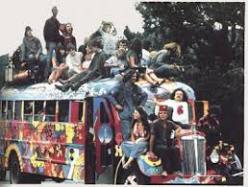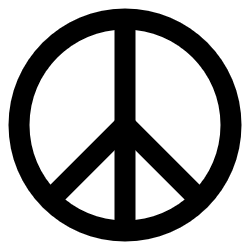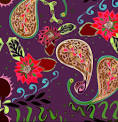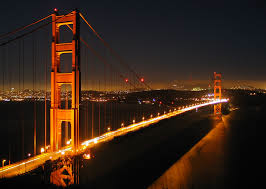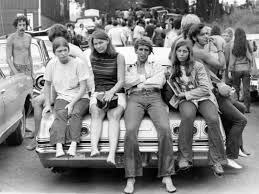‘My God! They’re Killing Us’: Newsweek’s 1970
Coverage of the Kent State Shooting
Crosby, Stills, Nash & Young Ohio 1970 Kent State University
https://youtu.be/68g76j9VBvM
Kent State University, in the rolling green hills of northeastern Ohio, seems the very model of a modern, Middle American university. Until last year, the most vicious outbreak of violence there was a 1958 panty raid launched against two women’s dormitories, which resulted in the prompt dismissal of 29 students. Recently, the radical spirit had begun to drift over the 790-acre campus—but only a fraction of the school’s 19,000 students was affected. Antiwar rallies attracted no more than 300 people at best, and even the appearance of Jerry Rubin of the Chicago Seven drew only about 1,000.
Given the setting, the sudden volley of rifle fire from National Guard troops that killed four Kent State students and wounded 10 others last week echoed even more loudly than it might have at one of the capitals of campus protest such as Berkeley or Columbia. The bloody incident shocked and further divided a nation already riven by dissent over the war in Indochina. More than that, the shots fired at Kent State were taken by some as a warning that the U.S. might be edging toward the brink of warfare of sorts on the home front.
Try Newsweek for only $1.25 per week
The prologue to the tragedy was probably provided by Richard Nixon himself four years earlier when he announced the U.S. intervention in Cambodia. The next day, Kent State students held peaceful protests rallies on campus. Later, the combination of warm spring air and cold beer at local taverns in Kent, a leafy community of 29,000 not far from Akron, prompted some young people to pitch a few bottles at police cars. When members of the town’s 20-man police force returned to clear the area around midnight, the scene turned violent—and the night ended with the sound of shattering bank and store windows as a campus-bound mob of several hundred students rampaged through town.
ROTC
Police charged that among the rioters they had spotted two militants just released from jail after serving six months on charges stemming from disorders last year. The students denied this. And the following night, antiwar elements rallied again, later turning their wrath—and fire bombs—on the rickety 24-year-old ROTC building on the Kent campus. With the building in ruins and the townspeople in an angry uproar, a request was made by Mayor Leroy Satrom that Governor James Rhodes call in the National Guard. “If these anarchists get away with it here,” said a lifelong Kent resident, “no campus in the country is safe.”
The governor was eager to oblige. Having made campus disorder a key issue in his hard campaign for the U.S. Senate, Rhodes quickly ordered in men from the 107th Armored Cavalry Regiment and the 145th Infantry Battalion, declared martial law—and then showed up himself to set the tone in a public address. Attributing the violence to students “worse than the ‘brownshirt’ and the Communist element and also the night-riders in the vigilantes…the worst type of people that we harbor in America,” the governor pledged: “We are going to eradicate the problem…. It’s over within Ohio.”
Orders
Off the podium, said a reliable source, Rhodes all but took personal command of the guardsmen. Without consulting top guard officials or the university administration, he reportedly ordered that all campus assemblies—peaceful or otherwise—be broken up and said the troops would remain on campus 12 months a year if necessary. “There was no discussion,” an insider informed Newsweek, “because it wouldn’t have done any good. The governor had made up his mind.”
The guardsmen were already tired and tense, having been brought in from five days on duty in the Cleveland area during the wildcat Teamsters strike. Though many were young and some were even Kent State students, most of the troopers seemed to share the antipathy to student protests characteristic of small-town Ohio. They got through Sunday with no serious incident. But with the start of classes on Monday, the scene was set for a fatal confrontation.
Despite Rhodes’s ban on rallies—or perhaps unaware of how all-embracing it was—antiwar students were gathering for a noon rally while hundreds of their less political schoolmates ambled from class to lunch. Five times a campus police official called for the students to disperse, but they ignored the directive and rang the iron “Victory Bell” usually sounded after football games. Finally, the guard began to move, fully loaded M-1 rifles at the ready, along with some “grease guns” (.45-caliber submachine guns) and .45 pistols. Barrages of tear gas from M-79 grenade launchers began to move the crowd of students up a knoll, at the top of which perched Taylor Hall, a modern, pillared building housing the College of Fine and Professional Arts, the Department of Architecture and the School of Journalism.
Hail
The eddying student mob pelted the guardsmen with rocks, chunks of concrete, the troopers’ own belching gas grenades and all the standard porcine epithets. From atop the knoll, known to trysters as “Blanket Hill” before the construction of Taylor Hall, a composite group of some 100 guardsmen from the 107th and 145th sent a smaller detachment of about 40 troopers down to clear the young people from a football field and parking lot. The hail of student-hurled rocks and cement continued. So did the guard’s gas barrage, until there were no gas grenades left. Several times, some of the troops were seen to kneel in what seemed to be firing positions, apparently to frighten off their attackers.
It was at this point, about 25 minutes after noon, as the smaller detachment marched back up to join the larger group, that guardsmen thought they heard a single shot. Almost instantly, there was a salvo from troopers on the knoll that lasted at least three seconds. No warning had been issued, and few students knew the guardsmen’s rifles were even loaded. ‘They’re firing blanks,” said one student to another, “otherwise they would be aiming into the air or at the ground.” And, indeed, some of the 16 or 17 guardsmen who fired about 35 rounds in all may have done just that; others, unbelievable as it seemed, had fired right into the crowd of students. The shrieks and moans that quickly filled the air foreshadowed the toll: four dead, 10 wounded, including a youth paralyzed from the waist down by a bullet in the spine. Ignoring cries for help, the guardsmen marched away.
Around Taylor Hall, the students, many with tears streaming down their cheeks, were horrified and enraged. “My God! My God! They’re killing us,” thought freshman Ron Steele of Buffalo. “I thought the soldiers had gone insane or it was some kind of accident.”
William Fitzgerald, a 29-year-old graduate student in history, felt it was no accident. “It was butchery,” cried Fitzgerald. And a correspondent for campus radio station WKSU told his editor, via walkie-talkie: “I’m coming back. I’m sick…disgusted.” Psychology professor Seymour Baron, who had persuaded guard Brigade General Robert Canterbury to have his men put up their weapons after the fusillade, now was arguing infuriated students out of trying to follow the troops across the Commons. “They’ll kill you,” he warned.
Not one of the four dead had been closer than 75 feet to the troops who had killed them—and there was not the slightest suggestion that they had been singled out as targets because of anything they had done. Indeed, all available evidence indicated that the four dead students were probably innocent bystanders.
- Sandy Scheuer, 20, of Youngstown, Ohio, had been searching for a lost dog on campus only shortly before the shooting, and a friend said she was on her way to a speech-therapy class when she was hit. “Sandy must have thought it was over and stood up,” said Sharon Swanson. “I saw her lying there, hit in the neck.”
- William Schroeder, 19, of Lorain, Ohio, an ROTC member, was watching “mainly because he was curious,” according to fellow psychology student Gene Pekarik.
- Allison Krause, 19, of the Pittsburgh area, was walking with her boyfriend to a class when the firing began. “She had just stopped to look around and see what was happening,” said a fellow student.
- Jeffrey Glenn Miller, 20, of Plainview, New York, who looked most like a radical, had carefully steered clear of the jumpy campus the night before and had told his mother by telephone: “Don’t worry, I’m not going to get hurt…. You know me, I won’t get that involved.” Miller’s connection with the militants with third-hand at best, judging by a mysterious note from a friend found later in his room. “I guess I missed you again,” it said. “My friends from Michigan are on their way here to start some trouble. I’ll look for you later.”
In the aftermath, Ohio guard brass obdurately defended the conduct of their men. They quickly whisked away the troops who had fired the fatal rounds and then tried to explain what had happened. First, they contended that the volley had not been ordered but that it was fired in response to a sniper’s bullet; the next day, they were forced to admit they had no real evidence of any such sniping. However, there was an unaccounted for bullet hole in a metal sculpture outside Taylor Hall that some felt was consistent with a sniper shot from a rooftop; and more mystery was added with reports that a bullet wound suffered by one victim, as well as some shell casings on campus, did not match the ammunition authorized for the guard.
Ultimately, guard commanders rested their case on what seemed an extraordinary Ohio National Guard regulation that permits each individual soldier to shoot when he feels his life is endangered. “I am satisfied that these troops felt that their lives were in danger,” said General Canterbury, 55, who was in charge of the troops. “I felt I could have been killed out there…. Considering the size of the rocks and the proximity of those throwing them, lives were in danger…. Hell, they were 3 feet behind us…. I do think, however, that under normal conditions, an officer would give the order to fire.”
‘Bastards’
Some guardsmen on campus evidenced little if any regret over the killings. “It’s about time we showed the bastards who’s in charge,” said one. And many of the townspeople of Kent shared the same sentiment. “You can’t really help but kind of think they’ve been asking for it and finally got it,” said a motel clerk. What did the troops who did the actual firing think? “They didn’t go to Kent State to kill anyone,” cried the wife of one of the men who fired at the students. “I know he’d rather have stayed home and mowed the lawn. He told me so. He told me they didn’t fire those shots to scare the students off. He told me they fired those shots because they knew the students were coming after them, coming for their guns. People are calling my husband a murderer; my husband is not a murderer. He was afraid.”
Even granting the genuine fear felt by the guardsmen, disturbing questions persist about their behavior during the episode. The guard insisted that the men fired as they were about to be “overrun” by the students. But if the troops were so closely surrounded, how was it that nobody closer than 75 feet away was hit? And if the rocks and bricks presented such overwhelming danger, how did the troops avoid even one injury serious enough to require hospital treatment?
If the danger was not quite as great as first portrayed, why could not the detachment’s cadre of officers—a top-heavy group of four or five captains and Brigadier General Canterbury himself—keep the men under control. A 22-year-old drama student named James Minard charged that he saw an officer give the command to fire. “This lieutenant had his arm raised and carried a baton,” Minard said. “When the baton came down, they fired. I was apparently the only one who saw it; nobody believed me.” A well-connected guard source flatly told Newsweek‘s James Jones and Jon Lowell: “There had to be some kind of preliminary order.”
Spark?
Ohio’s Democratic Senator Stephen Young said in Washington that he had learned the firing was actually touched off by a nervous guardsman whose rifle went off when he was hit by a tear-gas canister or rock. Other observers wondered whether a student photographer, armed while on assignment for the university and the police, might have provided the spark—although an initial police check indicated his gun had not been fired.
As a spring rain washed the bloodstains from the campus, Kent State President Robert I. White ordered the university closed (for the rest of the quarter, it developed), and asked for a high-level investigation of the entire affair. After a visit by six Kent students, President Nixon announced that such an inquiry would be conducted by the Justice Department. The guard itself and the Ohio state police are also investigating the shootings. But even before the evidence was in, 1,000 Kent State faculty members rendered a verdict of their own. Prevented from meeting on the campus, they crowded into a nearby Akon Unitarian church and passed this resolution: “We hold the guardsmen, acting under orders and under severe psychological pressures, less responsible for the massacre than are Governor Rhodes and Adjutant General [Sylvester] Del Corso, whose inflammatory statements produced these pressures.”
‘Do More’
Beyond that there was little left but to bury the dead. In New York City, nearly 5,000 mourners joined the family of Jeffrey Miller at services addressed by Dr. Benjamin Spock, who declared that the Kent State killings “may do more to end the war in Vietnam than all the rest of us have been able to do.” There were smaller, simpler services for Allison Krause, but emotions ran just as high in her hometown. “I can’t blame 18-year-olds for not wanting to go to Cambodia and be killed,” said Krause’s mother. “Look, I had a daughter and now she is dead.”
Allison’s father was even angrier. “May her death be on [Nixon’s] back,” he snapped. His daughter, he said, “resented being called a bum because she disagreed with someone else’s opinion.” “Is dissent a crime?” he asked. “Is this such a reason for killing her? Have we come to such a state in this country that a young girl has to be shot because she disagrees deeply with the actions of her government?”
Sighed a neighbor: “You have no idea how this has brought the whole thing about the war and campus dissent home to this neighborhood…no idea at all. If someone like Allison is killed, my God….”
This story originally appeared in the May 18, 1970, issue of Newsweek with the headline “My God! They’re Killing Us.”





